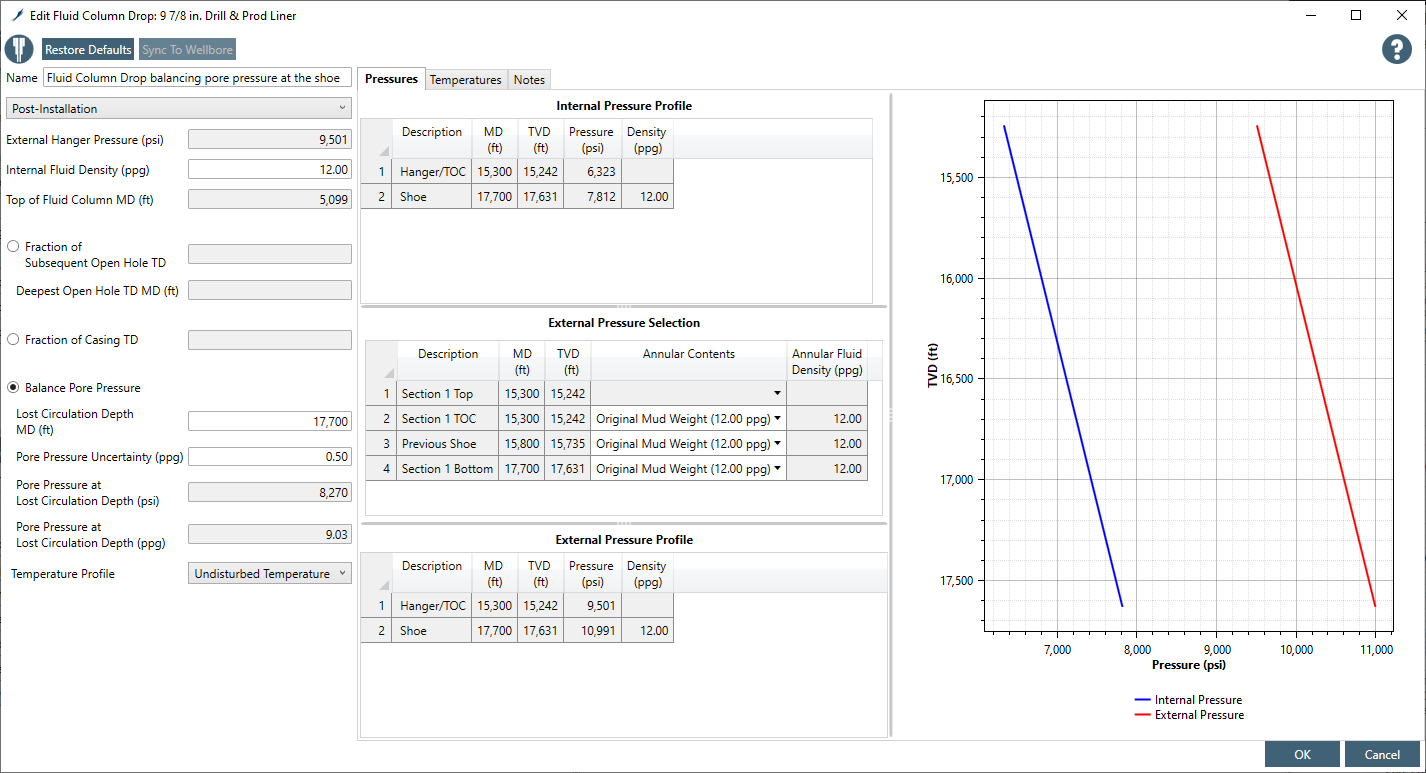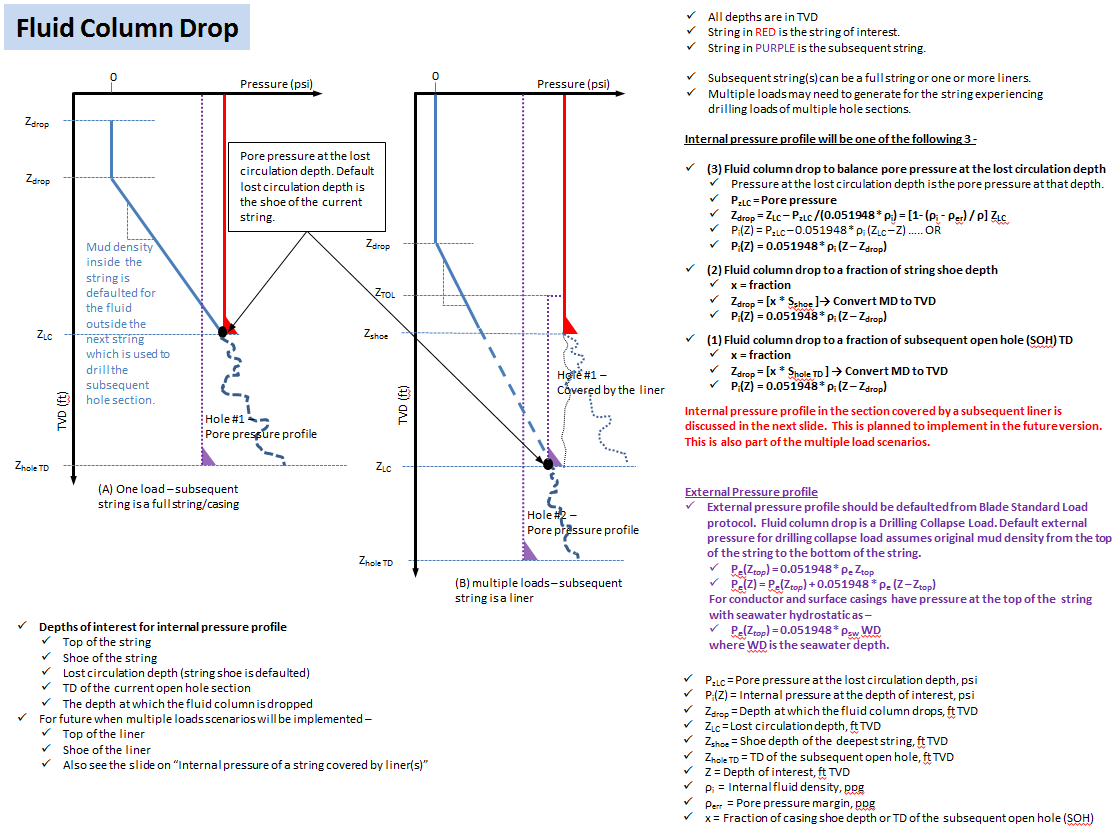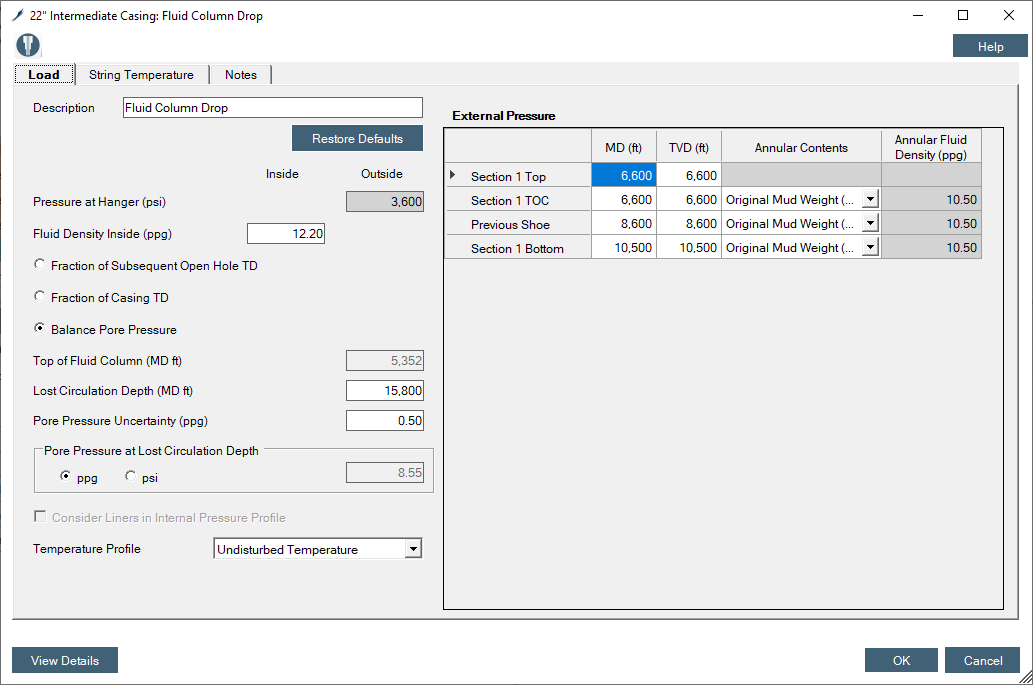¶ Fluid Column Drop
Fluid Column Drop is a post installation drilling collapse load. This load is required for all drilling strings and for those production strings that do experience drilling load of the subsequent hole section. Drilling fluid column outside drillstring (inside the string of interest) drops because the drilling mud density in the subsequent hole section is higher than the pore pressure in the open hole section. Lost circulation occurs at the depth in the open hole where the pore pressure is minimal. The default lost circulation depth is assumed to be the shoe of the deepest string and the drilling fluid density (fluid density inside the string) is defaulted to the fluid density for the open hole section.

The internal pressure for the fluid column drop can be calculated using one of the following three methods:
- Balancing Pore Pressure
- Fraction of Subsequent Open Hole (SOH) TD
- Fraction of Casing TD
¶ Balancing Pore Pressure
This load also known as Lost Return with Mud Drop. This is a drilling collapse load. This load occurs during a mud drop while drilling below the shoe. This mud drop is calculated by assuming the hydrostatic column of mud in the hole at the lost circulation depth equilibrates with a specific pore pressure at that depth. The default loss zone is the measured depth corresponds to the exposed shoe of the open hole of interest. Following information are required for this load:
- Lost circulation depth (measured depth)
- Pore pressure at lost circulation depth (defaulted from the pore pressure profile)
- Pore pressure margin of error (defaulted to zero ppg)
where,
- C = density to pressure conversion factor (0.051948)
- ρi = fluid density inside of the string (drilling mud for the subsequent hole section), ppg
- ρerr = error margin (uncertainty) of the pore pressure, ppg
- ρpp = pore pressure at the lost circulation depth, ppg
- zdrop = true vertical depth of the top of the fluid column after balancing pore pressure, ft TVD
- zLC = true vertical depth of the lost circulation depth1, ft TVD
- pzLC = pore pressure at the lost circulation depth, psi
- ppperr = pore pressure margin (uncertainty), psi
The internal pressure at the lost circulation depth equals to the pore pressure at that depth (obtained from the pore pressure profile). Therefore, the internal pressure assumes zero psi to a depth for which the drilling mud hydrostatic balances the pore pressure at the lost circulation depth.

¶ Fraction of Subsequent Open Hole (SOH) TD
Fluid column drops to a fraction of the total depth of the wellbore. Top of fluid column is calculated as: sdrop = x × sTD Then convert the measured depth sdrop to true vertical depth zdrop zdrop = [sdrop] → convert to TVD
where,
- sTD = measured depth of the TD of the subsequent open hole, ft MD
- sdrop = measured depth of the fluid column drop, ft MD
- zTD = true vertical depth of the TD of the subsequent open hole, ft TVD
- zdrop = true vertical depth of the fluid column drop, ft TVD
- x = fraction of open hole TD
¶ Fraction of Casing TD
Fluid column drops to a fraction of the string shoe depth. Top of fluid column is calculated as: sdrop = x × sshoe Then convert the measured depth sdrop to true vertical depth zdrop zdrop = [sdrop] → convert to TVD where,
- sshoe = measured depth of the TD of the current string shoe, ft MD
- sdrop = measured depth of the fluid column drop, ft MD
- zshoe = true vertical depth of the TD of the current string shoe, ft TVD
- zdrop = true vertical depth of the the fluid column drop, ft TVD
- x = fraction of string shoe depth. For FULL EVACUATION, x = 1.
¶ Internal pressure profile
Casing is often designed for collapse by assuming full internal evacuation of the string. This is an extremely severe condition, one that occurs rarely. A frequently used (alternative) rule for collapse design assumes evacuation of 1/3 or 1/2 DSOH for collapse loading. This rule, based on field experience, was proposed by Kastor 2.
An evacuated fluid column is usually the result of lost circulation. The height of the fluid lost can also be assessed by estimating the height of the column of drilling mud required to balance the pore pressure, or fraction of subsequent open hole depth or fraction of current casing shoe depth.
- Therefore, the internal pressure profile will be calculated using the following equation:
- pi(z) = C * pi * (z - zdrop) for z > zdrop
- pi(z) = 0 for z ≤ zdrop
where,
- z = true vertical depth of interest, ft TVD
- zdrop = true vertical depth of the lost circulation depth, ft TVD
- pi(z) = pressure at z, psi
In general, the more severe of the two internal pressure profiles (1/3 DSOH or mud weight balancing pore pressure at LC zone is used as the collapse load. In offshore wells, a marine riser is employed. If a lost circulation zone is encountered, the fluid level in the drillpipe-casing annulus will drop. The worst case for the riser could occur when the level of the fluid drops below the mudline (the "dry" riser). Risers are large do/t strings with relatively low collapse resistances. In deepwater wells, this case must be considered as part of the riser design.
¶ External pressure profile
Following is a brief summary of the external pressure profile for a collapse load according to Blade’s External Pressure Protocol:
- pressure at the hanger (top of the string)
- Phanger = C * Pmw * zML - offshore subsea wells and string drilled with riser
- Phanger = C * Psw * zWD - offshore subsea wells and string drilled without riser
- Phanger = C * Pmw * zTOL - liner
- 0 - offshore surface and onshore wells
Pressure between the hanger and the string shoe pe(z) = phanger + C × ρmw × (z−zhanger)
where
- ρmw = Original mud density, ppg
- zML = zRKB + zWD = Mud level, ft TVD
- zRKB = RKB Elevation, ft TVD
- zTOL = top of liner, ft TVD
- zhanger = top of the string, ft TVD. zhanger = zTOL for liner string and zhanger = zML for casing and tieback strings.
¶ Temperature profile
Undisturbed temperature profile is assumed as default. Drilling circulating temperature could also be an option to select.
¶ Comments
- Default lost circulation depth (for balance pore pressure) is the current string shoe depth assuming that the current shoe does have the minimum pore pressure. The better choice would be to find the location of the minimum pore in the subsequent hole to be drilled.
- Default fraction of subsequent open hole TD and fraction of casing TD for offshore subsea wells are estimated on the assumption that the fluid column dropped at the mudline. Therefore, the fraction will be as following:
- x = sML/sTD for fraction of subsequent open hole TD
- x = sML/sshoe for fraction of casing TD
- The fraction is calculated using the measured depths.
- For Onshore and Offshore Platform wells, fraction should be 0.0 for both choices.
- Multiple Load Scenario –
- The string with one or more subsequent liners will have multiple similar loads with a balancing pore pressure in each subsequent hole section.
¶ Data inputs
The following are the inputs for this load case -
- Description - Enter an appropriate name for the load to replace the default name.
- Pressure at Hanger outside the string - Default value is shown based on the calculation described earlier. User can change this pressure as appropriate.
- Fluid Density Inside Casing - Enter an appropriate drilling fluid density. Default density is mud density used in the subsequent hole section.
- Fraction of Subsequent Open Hole TD (0 - 1.0) - Enter an appropriate fraction to replace the default fraction of fluid evacuation. Default fraction drops the fluid to the mudline.
- Fraction of Casing TD (0 - 1.0) - Enter an appropriate fraction to replace the default fraction of fluid evacuation. Default fraction drops the fluid to the mudline.
- Balance Pore Pressure - Enter the lost circulation depth (ft MD). Default depth is the current string shoe depth.
- Pore Pressure Uncertainty - Enter pore pressure uncertainty for the ’Balance Pore Pressure’ option. The default value is 0.5 ppg
- Temperature Profile - Select an appropriate temperature profile for this load case. Undisturbed temperature has been selected as default.

The lost zone is the depth at which the pore pressure is the minimum while drilling a hole section. The drilling mud equalizes with the pore pressure and fluid is lost to the formation thereby dropping the fluid column. This creates partial/complete evacuation in the casing-drillstring annulus.
Kastor, R., "Casing Burst Design Criteria for Kick Pressure Control," paper SPE 4138 presented at the 47th Annual Fall Meeting of the Society of Petroleum Engineers of AIME, San Antonio, TX, Oct. 8-11, 1972.
